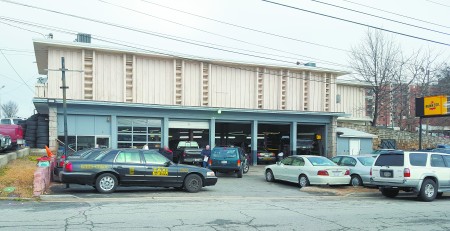The former Eddie’s Automotive on Mount Vernon Highway in Sandy Springs is historic, according to the state preservation office, a decision that has thrown a monkey wrench into city plans to replace the auto shop with new roundabouts and a park.
The city and state transportation officials dispute the designation. “We have checked and we have not been able to find any evidence George Washington had his horse fixed at Eddie’s Automotive,” Mayor Rusty Paul joked in a recent speech to a Buckhead community group, expressing the city’s frustration.

But Jennifer Dixon of the state Historic Preservation Division said the shop—now called Magic Mike’s Automotive—is a historic artifact of the car-driven development boom along Roswell Road during the 1960s.
“Therefore, it is HPD’s opinion that the auto service garage is significant as a good and representative example of this time period of development within the Roswell Road area and Sandy Springs as a whole,” Dixon said in an email. “Furthermore, it is HPD’s opinion that the auto service garage is a good and representative example of Contemporary architecture as applied to commercial development.”
The city sees the situation as another headache for its Mount Vernon roundabouts plan, which already had to be redrawn to accommodate another historic designation for an entire neighborhood off Johnson Ferry Road. That required taking more land in front of the Mount Vernon Towers senior residences, which has triggered intense controversy.
For years, the city has planned to reconfigure the unusual, X-shaped intersection of Mount Vernon Highway and Johnson Ferry Road into dual roundabouts. The plan involves acquiring the western triangle of land in the intersection where the auto shop sits near other commercial buildings that are now vacant. About half of the triangle site would be taken up by one of the roundabouts, while the rest, fronting on Roswell Road, would become a small park related to the City Springs project across the street.
The $14 million project entered the review pipeline in 2007, with GDOT agreeing to pay 80 percent of the cost. Some of the money comes from Federal Highway Administration funds. One string attached to federal funding is a review of a road project’s possible impacts on historic resources, Assistant City Manager Bryant Poole said.
Under the National Historic Preservation Act, that means identifying any adjacent properties that are on the National Register of Historic Places or that might be eligible because they are at least 50 years old. If there is such a property, Poole said, “you have to demonstrate you’ve done everything you can do not to impact the resource.”
In 2009, the city conducted the historic survey, which found that the Glenwood Forest subdivision to the south of Johnson Ferry is historic as an example of mid-20th century architecture. GDOT and the Historic Preservation Division agreed with that designation and the city shifted the roundabouts plan northward to take only a small sliver of right of way in the Glenwood Forest area. The Preservation Division later ruled the project would have “no adverse effect,” meaning no historic mitigations are needed.
But as the roundabouts plan headed into final design and got in line for funding, the auto shop recently passed its 50th birthday and required historic review as well, Poole said. This time, the Preservation Division and GDOT were at odds.
Dixon called it “a rare professional disagreement regarding the historic status of the auto repair shop.”
The city still is deciding on its official response, Poole said. An appeal is possible, and the historic designation does not bar redevelopment, but could require mitigations ranging from moving the entire building to erecting a memorial plaque on its site, Poole said.
“We and GDOT think it doesn’t require historic review,” Poole said. “We’re trying to determine the next step. Do we challenge it?”
The city can’t simply shift the design off of the auto shop site as it did for Glenwood Forest. Paul said at a recent City Council meeting that he petitioned members of Congress to remove the historic review requirement for this particular project in the federal funding bill, but Poole said that move came too late.
The city may appeal the historic designation to the Federal Highway Administration via GDOT, which could take a year or more, Poole said. Another option is giving up on federal funding and using only city money. Or the city may have to do some form of mitigation for demolishing the building.
“Please know, this process is simply that, a process—once complete, the project continues,” Dixon said.

Great repair shop. Nice people, fair price. Another “small” park on a busy 4 lane rd. in Sandy Springs. Millions of dollars for a postage stamp sized park seems like a waste of city money.